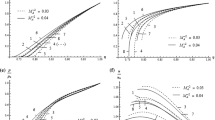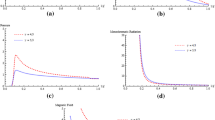Abstract
We investigated the exact similarity solutions for shock wave propagation in non-ideal gas with radiation heat flux under gravitational field by taking radiation pressure and radiation energy into account in the presence of azimuthal magnetic field for spherical geometry. The solutions are in terms of analytical expressions. Similarity method is used to transform the basic equation from a system of partial differential equation into a system of ordinary differential equations. The system of ODE yields exact solutions for initial magnetic field distributions as power law. Consideration of isothermal approximations, radiation pressure, radiation energy and adiabatic compressibility in gravitating medium into accounts leads to new insights into explosion problem in contrast to earlier model. Finally, the product solution of progressive wave given by Mc. Vittie is used to obtain the exact similarity solution under the consideration that the radiation pressure is not equal to zero and the energy loss due to radiation escape is significant. The Alfven–Mach number effect, the parameter of gravitational effect, the parameter of non-idealness of the gas, the radiation pressure number and the adiabatic exponent gamma of the gas are discussed in detail.



Similar content being viewed by others
References
Sedov LI (1946) Propagation of strong shock waves. J Appl Math Mech 10:241–250
Taylor G (1950) The formation of a blast wave by a very intense explosion. I. Theoretical discussion. Proc R Soc Lond Ser A 201:159–174
Noh WF (1987) Errors for calculations of strong shocks using an artificial viscosity and an artificial heat flux. J Comput Phys 72:78–120
Meyer HWJ (1988) Derivation of a Godunov one dimensional fluid dynamics code, technical report, Army Ballistic Research Lab Aberdeen Proving Ground MD
Gehmeyr M, Cheng B, Mihalas D (1997) Noh’s constant-velocity shock problem revisited. Shock Waves 7:255–274
Allen GE, Chow K, DeLaney T, Filipovic MD, Houck JC, Pannuti TG, Stage MD (2015) On the expansion rate, age, and distance of the supernova remnant G266.2-1.2 (Vela Jr.). Astrophys J 798:82
Leahy DA, Ranasinghe S (2016) Distance and evolutionary state of the supernova remnant 3C 397 (G41.1-0.3). Astrophys J 817:74
Lerche I, Vasyliunas VM (1976) Mathematical theory of isothermal blast waves and the question of their applicability to supernova remnants. Astrophys J 210:85–99
Solinger A, Buff J, Rappaport S (1975) Isothermal blast wave model of supernova remnants. Astrophys J 201:381–386
Vink J (2012) Supernova remnants: The X-ray perspective. Astron Astrophys Rev 20:49. https://doi.org/10.1007/s00159-011-0049-1
Woltjer L (1972) Supernova remnants. Ann Rev Astron Astrophys 10:129–158
Sedov LI (1959) Similarity and dimensional methods in mechanics. Academic Press, New York
Korobeinikov VP (1956) The problem of a strong point explosion in a gas with zero temperaturegradient. Dokl Akad Nauk 109:271–273
Korobeinikov VP (1976) Problems in the Theory of Point Explosion in Gases. American Mathematical Society, Providence
Zel’dovich Ya B, Raizer YuP (1967) Physics of shock waves and high temperature hydrodynamic phenomena, vol II. Academic Press, New York
Lerche I (1977) Isothermal self-similar blast wave theory of supernova remnants driven by relativistic gas pressure. Astrophys Space Sci 50:323–342
Stephan C, Deschner Y, Tobias F, Illenseer Y, Wolfgang J, Duschl Z (2018) Self-similarity solutions to isothermal shock problems, SIAM. J Appl Maths 78:80–103
Sponholz H, Molteni D (1994) Steady-state shocks in an accretion disc around a Kerr black hole. MNRAS 271:233–242
Kato S, Inagaki S, Mineshige S, Fukue J (1996) Physics of accretion disks. Gordon and Breach, Amsterdam
Kato S, Fukue J, Mineshige S (1998) Black-hole accretion disks. Kyoto Univ. Press, Kyoto
Abramowicz MA, Chakrabarti SK (1990) Standing shocks in adiabatic black hole accretion of rotating matter. ApJ 350:281–287
Yang R, Kafatos M (1995) Shock study in fully relativistic isothermal flows, 2. A&A 295:238–244
Lu JF, Yuan F (1997) Isothermal Shocks in adiabatic black-hole accretion flows. PASJ: Publ Astron Soc Jpn 49:525–533
Lu JF, Yuan F (1998) Global solution of adiabatic accretion flows with isothermal shocks in Kerr black hole geometry. Mon Not R Astron Soc 295:66–74
Fukumura K, Tsuruta S (2004) Isothermal shock formation in nonequatorial accretion flows around Kerr black holes. APJ 611:964–976
Carrus P, Fox P, Hass F, Kopal Z (1951) The propagation of shock waves in a stellar model with continuous density distribution. Astrophys J 113:496–518
Rogers MH (1957) Analytic solutions for blast wave problem with an atmosphere of varying density. Astrophys J 125:478–493
Summers D (1975) An idealized model of a magnetohydrodynamic spherical blast wave applied to a flare produced shock in the solar wind. Astron. Astophys. 45:151–158
Lee TS, Chen T (1968) Hydrodynamic interplanetary shock waves. Planet Space Sci 16:1483–1502
Wang KC (1964) The piston problem with thermal radiation. J Fluid Mech 20:447–455
Vishwakarma JP, Shrivastava RC, Kumar A (1987) An exact similarity solution in radiation magneto gas dynamics for the flows behind a spherical shock. Astrophys Space Sci 129:45–52
Marshak RE (1958) Effects of radiation on shock wave behavior. Phys Fluids 1:24–29
Elliot LA (1960) Similarity methods in radiation hydrodynamics. Proc R Soc 258A:287–301
Sachdev PL, Ashraf S (1970) Exact similarity solution in radiation-gas-dynamics. Proc Indian Acad Sci A71:275–281
Verma BG, Vishwakarma JP (1978) An exact similarity solution for spherical shock wave in magnetoradiative gas. Astrophys Space Sci 58:139–147
Rosenau P (1977) Equatorial propagation of axisymmetric magnetohydrodynamic shocks II. Phys Fluids 20:1097–1103
Shaviv NJ (2000) The porous atmosphere of η Carinae. Astrophys J 532:L137–L140
Pegoraro F, Bulanov SV (2007) Photon Bubbles and ion acceleration in a plasma dominated by the radiation pressure of an electromagnetic pulse. Phys Rev Lett 99:065002
Arons J (1992) Photon bubbles: overstability in a magnetized atmosphere. Astrophys J 388:561
Esirkepov T, Borghesi M, Bulanov SV, Mourou G, Tajima T (2004) Highly efficient relativistic-ion generation in the laser-piston regime. Phys Rev Lett 92:175003
Macchi A, Cattani F, Liseykina TV, Cornolti F (2005) Laser acceleration of ion bunches at the front surface of over-dense plasmas. Phys Rev Lett 94:165003
Goldreich P (1978) On the radiative acceleration of quasar absorption line clouds. Phys Scr 17:225
Landau LD, Lifshitz EM (1975) The classical theory of fields. Pergamon Press, New York
Borghesi M, Fuchs J, Bulanov SV, MacKinnon AJ, Patel PK, Roth M (2006) Fast ion generation by high-intensity laser irradiation of solid targets and applications. Fus Sci Technol 49:412–439
Moon SJ, Wilks SC, Klein RI, RemingtonB A, Ryutov DD, Mackinnon AJ, Patel PK, Spitkovsky A (2005) A neutron star atmosphere in the laboratory with petawatt lasers. Astrophys Space Sci 298:293–298
Mourou GA, Tajima T, Bulanov SV (2006) Optics in the relativistic regime. Rev Mod Phys 78:309–371
Kifonidis K, Plewa T, Janka HTh, Müller E (2003) Non-spherical core collapse supernovae I. Neutrino-driven convection, Rayleigh-Taylor instabilities, and the formation and propagation of metal clumps. Astron Astrophys 408:621–649
Robinson APL, Zepf M, Kar S, Evans RG, Bellei C (2008) Radiation pressure acceleration of thin foils with circularly polarized laser pulses. New J Phys 10:013021
Tamburini M, Pegoraro F, Piazza A, Di Keitel CH, Macchi A (2010) Radiation reaction effects on radiation pressure acceleration. New J Phys 12:123005
Badziak J, Glowacz S, Jablonski S, Parys P, Wolowski J, Hora H, Krása J, Láska L, Rohlena K (2004) Production of ultrahigh ion current densities at skin-layer subrelativistic laser-plasma interaction. Plasma Phys Control Fus 46(B):541–556
Kar S et al (2008) Plasma jets driven by ultraintense-laser interaction with thin foils Phys. Rev Lett 100:225004
Akli KU et al (2008) Laser heating of solid matter by light-pressure-driven shocks at ultrarelativistic intensities Phys. Rev Lett 100:165002
Macchi A, Veghini S, Tatyana V (2010) Liseykina and francesco pegoraro, radiation pressure acceleration of ultrathin foils. New J Phys 12:045013
Krumholz MR, Christopher DM (2009) The dynamics of radiation pressure dominated H-II regions. Astrophys J 703:1352–1362
Ashkin A (1970) Acceleration and trapping of particles by radiation pressure. Phys Rev Lett 24:156–159
Letokhov VS (1977) Laser control of atomic motion: velocity selection, cooling and trapping. Comments At Mol Phys 6:119–131
Wineland DJ, Drullinger HE, Walls FL (1978) Radiation pressure cooling of bound resonant absorbers Phys. Rev Lett 40:1639–1642
Ashkin A (1980) Applications of laser radiation pressure. Science 210:1081–1088
Vishwakarma JP, Nath G (2010) Propagation of a cylindrical shock wave in a rotating dusty gas with heat conduction and radiation heat flux. Phys Scr 81:045401
Vishwakarma JP, Nath G (2012) Spherical shock wave generated by a moving piston in mixture of a non-ideal gas and small solid particles under a gravitational field. Commun Nonlinear Sci Numer Simul 17:2382–2393
Anisimov SI, Spiner OM (1972) Motion of an almost ideal gas in the presence of a strong point explosion. J Appl Maths Mech 36:883–887
Ranga Rao MP, Purohit NK (1976) Self-similar problem in non-ideal gas. Int J Eng Sci 14:91–97
Wu CC, Roberts PH (1993) Shock wave propagation in a sonoluminescing gas bubble. Phys Rev Lett 70:3424–3427
Roberts PH, Wu CC (1996) Structure and stability of a spherical implosion. Phys Lett A 213:59–64
Nath G (2015) Similarity solutions for unsteady flow behind an exponential shock in an axisymmetric rotating non-ideal gas. Meccanica 50:1701–1715
Vishwakarma JP, Nath G (2007) Similarity solutions for the flow behind an exponential shock in a non-ideal gas. Meccanica 42:331–339
Vishwakarma JP, Nath G (2009) A self-similar solution of a shock propagation in a mixture of a non-ideal gas and small solid particles. Meccanica 44:239–254
Nath G, Dutta M, Pathak RP (2017) An exact solution for the propagation of shock waves in selfgravitating medium in the presence of magnetic field and radiative heat flux. Model Measur Control B 86(4):907–927. https://doi.org/10.18280/mmc_b.860406
Rosenau P, Frankenthal S (1976) Shock disturbances in a thermally conducting solar wind. Astrophys J 208:633–637
Rosenau P, Frankenthal S (1978) Propagation of magnetohydrodynamic shocks in a thermally conducting medium. Phys Fluids 21:559–566
Helliwell JB (1969) Self-similar piston problems with radiative heat transfer. J Fluid Mech 37:497–512
Vishwakarma JP, Pandey VK (2013) Magnetogasdynamic spherical shock waves in a non- ideal gas with radiation. Int J Appl Math Mech 9:91–102
Bhowmick JB (1981) An exact analytical solution in radiation gasdynamics. Astrophys Space Sci 74:481–485
Mc Vittie G C (1953) Spherically symmetric solutions of the equations of gas dynamics. Proc Roy Soc 220:339–455
Nath G, Vishwakarma JP, Shrivastava VK, Sinha AK (2013) Propagation of magnetogasdynamic shock waves in a self-gravitating gas with exponentially varying density. J Theor Appl Phys 7:1–8
Whitham GB (1958) On the propagation of shock waves through regions of non-uniform area or flow. J Fluid Mech 4:337–360
Landau LD, Lifshitz EM (1958) Course of theoretical physics, statistical physics, vol 5. Pergamon Press, Oxford
Chandrasekhar S (1939) An introduction to the study of stellar structure. University Chicago Press, Chicago
Pai SI (1969) Inviscid flow of radiation gasdynamics (High temperature inviscid flow of ideal radiating gas, analyzing effects of radiation pressure and energy on flow field). J Math Phys Sci 3:361–370
Vishwakarma JP, Patel N (2015) Magnetogasdynamic cylindrical shock waves in a rotating non-ideal gas with radiation heat flux. J Eng Phys Thermophys 88:521–530
Author information
Authors and Affiliations
Corresponding author
Additional information
Publisher's Note
Springer Nature remains neutral with regard to jurisdictional claims in published maps and institutional affiliations.
Significance statement
Exact similarity solution for magnetogasdynamic shock waves in non-ideal gas with radiation flux under gravitational field with radiation pressure and radiation energy is studied. The product solution of progressive wave given by Mc. Vittie is used to obtain the exact solution. The radiation pressure is taken into consideration. The radiation pressure is used for cooling such as radiation-pressure cooling of bound resonant absorbers which is elastically bound to laboratory fixed equipment in optical levitation of liquid drops. Other major application of radiation pressure is in the study of the light scattering.
Rights and permissions
About this article
Cite this article
Nath, G., Dutta, M. & Pathak, R.P. Exact Similarity Solution for the Propagation of Spherical Shock Wave in a van der Waals Gas with Azimuthal Magnetic Field, Radiation Heat Flux, Radiation Pressure and Radiation Energy Under Gravitational Field. Proc. Natl. Acad. Sci., India, Sect. A Phys. Sci. 90, 789–801 (2020). https://doi.org/10.1007/s40010-019-00625-4
Received:
Revised:
Accepted:
Published:
Issue Date:
DOI: https://doi.org/10.1007/s40010-019-00625-4




